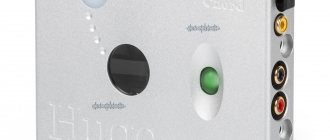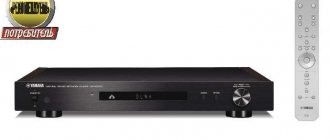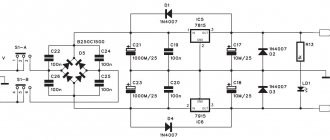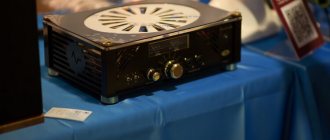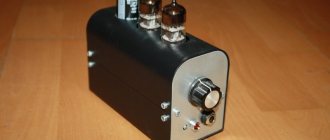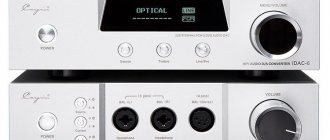Hugo 2 lost its Product of the Year status, but otherwise retained its position. A bright representative of the stellar family, it is the next step after Mojo and a more mobile version of Qutest.
Save and read later -
Its portability lies in the presence of a battery that provides seven hours of sound on a single charge, and in a fairly modest weight (450 grams) - although, of course, carrying it in your pocket is not as convenient as Mojo. However, Chord considers the “two” not only as a portable device, but also as a DAC and preamplifier for a stationary system, which is proven by the presence of a remote control in the kit.
No DAC in a similar price category can compare with the quality of the Hugo 2
Hugo 2 is equipped with every type of input and output you could reasonably want. The digital optical input (full size TOSLink) accepts digital signals up to 24-bit/192 kHz, and the 3.5mm digital coaxial input up to 24/384.
The mini-USB port supports PCM formats up to 32-bit/768 kHz and DSD512. In addition, music can be streamed to Hugo 2 via aptX Bluetooth. In addition to headphone outputs with 3.5 and 6.3 millimeter jacks, there are a pair of stereo RCA outputs for connecting to an amplifier.
The Hugo 2 features color-changing controls for selecting inputs and volume, as well as mysterious cross-feeding and filters. One of the main advantages of Chord, field programmable gate arrays, has become even more serious in Hugo 2.
We have no complaints about the quality of processing of digital audio files. The higher the resolution, the more information Hugo 2 has and the greater the detail and fidelity of the music. But in any case, it creates a dynamic, detailed and energetic sound.
There is strength in unity
Perhaps the main advantage of Hugo 2 is its rhythmicity, thanks to which ensemble recordings performed by it sound extremely convincing. It is impossible not to note the clarity and purity of sound, excellent processing of tempo rhythms and an uncompromising approach to building a sound stage.
In the subranges, Chord demonstrates a completely neutral balance - there is enough of everything, and nothing stands out. It organizes any composition into a compelling whole, balancing high and low frequencies flawlessly and naturally.
No DAC in this price category is so easy, accurate and comprehensive in conveying emotions. Our love for him has not diminished over the past year.
Chord Electronics Hugo TT 2
The Hugo TT2 is a new desktop DAC and headphone amplifier with the world's most advanced digital features second only to the flagship DAVE. As part of Chord Electronics' ongoing digital development, the new Hugo 2 TT brings the power of Rob Watts' digital-to-analog conversion algorithms into a compact, mains-powered package.
Chord Electronics' approach to the production of digital audio equipment is strikingly different from the generally accepted one. Instead of buying ready-made chips and trying to achieve the desired sound character by selecting the DAC chips themselves, their power supply and output amplifier circuits, Chord Electronics transfers the entire digital-to-analog conversion process into microcode space, low-level instructions for a standard signal processor. Thus, it turns out that this transformation realizes characteristics absolutely unattainable by all other manufacturers through the art of programming. The microcode itself is loaded into a programmable FPGA (FPGA). The computing power of this matrix determines the depth and speed of calculations, therefore, with the advent of new, more powerful FPGA chip assemblies on the market, Chord Electronics chief digital genius Rob Watts is developing his unique algorithms towards even greater accuracy in reconstructing the original music signal.
Chord Electronics' new generation of digital technology, which began deployment in 2017-18, is based on the new programmable matrix Atrix 7. In it, Rob Watts used 86 processor cores at a frequency of 208 MHz, thanks to the calculations on which the proprietary WTA software digital filter with 16x resampling and 98304 weighting coefficients. This filter is 5 times more powerful than the filter of the previous version of this DAC (Hugo TT). Due to the increase in computing power, as well as optimized programming of the 12th order noise shaper, the resolution of the new DAC exceeds the resolution of the previous generation of digital technology by more than 100,000 times!
The Hugo TT 2's analog output stage is a new discrete design, and the mains power supply provides enormous power reserves with peak currents of up to 5 A and output voltages of up to 9.3 Vrms. The functionality of the DAC in the Hugo TT 2 is identical to the custom set of the portable Hugo 2, that is, it allows you to choose between four digital filtering options and the inclusion of a stereo widener for crossfeed headphones.
Hugo TT 2 can work as a DAC with line output or as a preamplifier. By adding the compact TToby power amplifier to the Hugo TT 2, you can get a compact desktop system with an unrivaled digital engine and advanced functionality for any digital sources.
Digital inputs 1x USB Type-B, 2x Coax BNC and 2x Optical are compatible with PCM signals with sampling rates from 44 to 384 kHz; on the USB input, when using Windows OS and specialized drivers, the DSD stream (from 64 to 512) is received without conversion (native ).
The kit includes an external power supply, USB cable, and remote control. Finish options: black and silver.
DAC + headphone amplifier Chord Electronics Hugo TT
The British company Chord Electronics has always seemed to me like a quirky cousin in the audio world: but their product policy only seems strange from the outside, in fact they do everything with prudence and do their own thing. Their examples of design work are often extremely provocative, bordering on the "regular audiophile's" understanding of good taste. In addition, many of my fellow audio enthusiasts have endless faith in the audio components used by Chord, and I myself have seen them used at many respected audio shows.
Price 4795 USD
Chord's new product, the Hugo TT (DAC and Headphone Amplifier), is inspired by other distinctive products from Chord, including the QBD76 HDSD DAC, Chordette QuteHD DAC and Hugo-branded portable DAC. I noted that each of these products was presented at CES (Consumer Electronics Show), but who would look closely at them in crowded hotel rooms? So, when the Hugo TT ($4,795) became available for review, I jumped at the chance to check out just what that weird sound was all about.
Frame
The first thing that caught my eye was that the Hugo TT (according to the Chord TT itself means Table Top - tabletop device) looks and feels like a monolithic piece of metal - if you knock on its body, you will not hear a ringing echo anywhere. Chord have so skillfully connected the upper and lower parts of the body that the thin seam between them is almost indistinguishable. The TT comes in two colors – black and silver. I used the stunning black option in my review.
The next thing I noticed was how the TT's design looked heavier and more angular than other Chord products. The owner's manual states that the TT weighs 2.99kg, but I feel like it's 4.5kg. There was nothing left to do but weigh the product, and it turned out that the management was not deceived. Hugo's small dimensions (23.4 cm wide, 4.6 cm high, 22.3 cm deep) are misleading to the eye.
Next, the whimsical nature of Chord begins to reveal itself. The two 5cm wide recesses are cut in a different manner: one is made in the center of the top panel, towards the back, and the other is cut right into the top edge of the front panel. From the depths of the latter, like a big eye, a green alphanumeric screen looks at the user. Various recesses of different sizes (except for two recesses, all the others are round) are scattered across the entire surface of the front panel: buttons, connectors, a sensor, a switch and a logo - they are all recessed. Apart from the connectors on the rear panel, nothing protrudes at all in any part of the case. All this creates a smooth and strong image for Hugo, while the black color gives a touch of the mystical.
From left to right on the front panel there are: under the green display, two small shiny metal buttons labeled “IP” and “X-PHD” and designed to switch the input and Crossfeed mode (we'll look at the latter mode later). Behind the buttons is the remote control sensor. In the middle is the Chord logo, and below it is the power button. To the right of them are three headphone jacks: one 3.5 mm. right in the center of the recess, set far enough to accept a rectangular plug; behind it are two 6.3mm jacks. All three jacks can be used simultaneously and are designed to match headphones with impedances ranging from four to several hundred ohms.
Below the previously mentioned cutout on the top panel there is a glass insert. In fact, this is a volume control center that changes color depending on how you touch it: swiping to the right decreases the volume, swiping left increases the volume (which seemed a little counterintuitive to me - usually moving the levers to the right increases the volume). The Table Top product name should be taken literally: this DAC is not designed to fit into regular stands, otherwise you will be unable to access the volume control, or you will have to use the remote control.
In the center of the top cover, right in front of the volume control, there is a lens through which part of the circuit board and multi-colored LEDs are visible, the most useful purpose of which is to indicate the sampling rate. Red signifies 44.1 kHz, and as the frequency increases, it changes through the full color gamut - shades of yellow, green and blue - until pure white, indicating DSD. It took me a long time to learn to distinguish the green colors of the 96 kHz frequency from the yellow-green 88.2 kHz, while the other colors were more contrasting.
When you turn on the power, Hugo TT begins to play with different colors. I still can't quite reconcile the psychedelic design of Hugo (and many other Chord products) with the level-headed demeanor of most of the Chord executives I've met. And the conclusion I have come to is unlikely to be news to anyone: the British mind is quite a complex thing.
Back panel
The Hugo TT's control layout may seem a little crazy, but the back cover is a return to 'normal'. From left to right: power supply connector, balanced (XLR) and unbalanced (RCA) outputs, coaxial connector supporting sampling rates up to 384 kHz (BNC with transition to standard S/PDIF RCA using an adapter, which is what I used for my S /PDIF cable from Cardas) and an optical connector supporting up to 192 kHz.
To the very right are two galvanically isolated USB Type B connectors, labeled SD (Standard Definition) and HD (High Definition). The SD input supports sampling rates up to 48 kHz and does not require installation of additional drivers when working with any sources, including iPad or iPhone. The HD connector I used to evaluate sound quality is asynchronous and uses Chord's own digital clock generator. Audio sources up to 384 kHz PCM/DXD are supported, as well as DSD64 and DSD128 in DoP (DSD over PCM) format. Hugo TT did not require any additional drivers to be installed when connecting an Apple MacBook Pro running Roon (DSD-enabled playback software). Personally, I haven’t checked, but Chord indicate that to work via HD input with Windows and support sampling rates up to 384 kHz, you need to install drivers from the included flash drive.
Connecting the connectors does not pose any difficulties, but their purpose is engraved on the case without applying paint, which makes it difficult to read when using the black version of the case without additional light sources.
In addition, the Hugo TT combines a proprietary input module with the aptX Bluetooth codec to support wireless connection - convenience of connection at the expense of sound quality. In the middle of the left cover of the Hugo there is a large semi-cylinder-shaped cutout, covered in black translucent plastic, where the Bluetooth antenna is located. I tested the functionality in Bluetooth mode at a distance of up to 20 meters using an iPhone 6 and everything was great. According to Chord, the operating range can reach 45 meters. The sound was very similar to a CD stream, it's a compressed signal - great for parties, but refrain from doing so if you can use cable.
Control
In my review of the Rega Research DAC-R, I slightly criticized the company for their button-strewn remote control, which can only be useful if the rest of the system is also made by Rega. The Hugo TT remote control is also generously decorated with buttons, which are impossible to use without purchasing other Chord products, but at least they include all the basic functions of the DAC: switching the input used, volume, mute, and separate numbered buttons for each input (very convenient for comparing different signal sources).
The remote control is made of aluminum alloy with small rubber feet. Comparable in size to SSD drives, looks great and is easy to use. Just like on the Hugo TT, each button sits in its own recess, which requires you to directly press it with your fingertip - the volume won't suddenly change if someone accidentally puts a book on the remote. But on the other hand, to issue a command using this remote control, much more effort is required compared to conventional remote controls. I noticed one strange thing - the input switch on the TT was sometimes triggered by the remote control of the Oppo BDP-103 universal player. And until I realized this, I thought it was a glitch in the TT with arbitrary input switching.
I think it's worth mentioning that when going through the preparation procedure after switching on, the output mode of the Hugo TT can be either adjustable (for use as a headphone amplifier or preamplifier) or fixed (when using a separate preamplifier). I warn you that when you select a fixed mode, the signal level of the headphone outputs is also set to maximum. Fad! My Benchmark DAC2 HGC behaves at a similar level, but visually you can always determine the position of the volume lever before connecting. When working with the Hugo TT, you need to pay attention to the color of the volume control and remember what it corresponds to. Therefore, if you want to use the Hugo as a regular DAC along with a preamp during the day, and later in the evening as a headphone amplifier, you must not forget to reset the volume control level. I say this from my own experience.
Inside
Many processes take place inside the Hugo TT, the primary of which can be considered the use of a built-in battery, installed to isolate it from interference that penetrates the electrical network, but not to ensure the mobility of the DAC. Chord warns tweakers not to replace the power supply supplied with the Hugo, since only it is optimized for recharging this battery: using other power supplies will void the factory warranty. Once the battery is fully charged, you can use the DAC without the power supply connected, but per Chord's recommendation, I kept it connected throughout my tests. The state of charge of the battery is indicated - and there is no surprise here - by the color of the corresponding indicator. Fully charging the battery takes about five hours.
The heart of the Hugo TT is the Field-Programmable Gate Array (FPGA), with which engineer Rob Watts was able to optimize the DAC's performance. I once met with Watts, and he explained to me the choice of this approach to building the device. When using an FPGA, it becomes possible to select the value of each parameter to immediately evaluate the output sound, allowing engineers to get closer to the desired result.
And Chord is actively involved in selection and customization. For example, their employees tested various noise shaping options until the measured and audible results met their expectations. Another essential part of the Chord approach is the Hugo TT's interpolation filter, which is used to recreate data lost after signal sampling. Watts explained that running a digital filter with an infinite number of delay line points also requires an infinite amount of RAM to create a transient response of incredible clarity, which is what is required to perfectly recreate the original analog waveform. But such technologies are not available in the present or foreseeable future, and based on many sound tests, Watts created his own WTA (Watts Transient Aligned) filtering algorithm.
But even when using the WTA algorithm, increasing the number of points improves the sound characteristics. Thus, the Hugo TT uses a WTA filter with a number of points of 26,368: this figure in itself speaks of excellent processing accuracy. Watts gave me diagrams for comparison illustrating the performance of the WTA filter in processing a sine wave signal compared to “conventional” filters. And this difference was obvious - when using the WTA filter, the signal looked smooth, while a “regular” DAC produced a signal with visible “thresholds”, which, according to Chord, leads to high-frequency distortion and jitter.
Chord also recognizes that the level of induced noise affects the "brightness" or "harshness" of the DAC's sound and goes to great lengths to eliminate this noise through proper power supply design, a four-level grounding circuit, and an additional layer of filtering for the DSD signal due to the large the amount of high-frequency noise present in it. Chord combats jitter with its proprietary digital phase-locked loop, which is also integrated into the FPGA.
Listening
Once the battery was fully charged, I connected the Hugo TT to my main system and fed it through the S/PDIF output of the Meridian Sooloos Control 15. The Chord replaced the Rega DAC-R ($1,195), which I had just finished reviewing and immediately discovered small but noticeable improvements in sound. The Rega sound was slightly dense (with a predominance of low frequencies), while the Chord did not have any thickening at all. Not a bad start.
I then had the opportunity to compare the TT with some more DACs, the first of which were Auralic's Vega and Ayre Acoustics' QB-9DSD. After another couple of weeks, Philip O'Ganlon, a representative from the distributor of On a Higher Note, suggested that I take the Luxman DA-06, which Art Dudley had reviewed, for comparison. If I add my own Benchmark DAC2 HGC to this list, I began to fear getting lost among these DACs.
Tony Holt, co-founder of the Central Coast Audio Club, came to my aid. We quickly sketched out a plan to compare different DACs with one set of tracks, with the tune "Pipeline" wandering from one to another, recorded first by The Chantays, then by the Lively Ones, and then by Stephen Ray Vaughn and Joe Weed. Rounding out the list was Bill Frisell and his stunning version from Guitar in the Space Age! (file in PCM format, OKeh).
First, we set about adjusting the volume levels of our DACs, which were all initially set to different values, and which could distort the test results. Once that was done, we started playing all of the listed performances of “Pipeline” on each DAC, and finally compared the simultaneous playback of the versions from the Chantays and Frisell. The only thing that saved us was that we adore this song.
Benchmark's DAC2 HGC ($1,995) quickly fell out of the competition because... In my opinion the sound was a little papery, but in Tony's opinion the sound was lighter than with other DACs. When comparing Benchmark's product in a simultaneous playback test, we came to a consensus that the Chord product sounded more spacious and dynamic. 1:0 in favor of Chord.
Luxman's DA-06 ($4,990) stood out in other ways: according to Tony, the sound was more soothing and smooth than the Chord product, although to me it lacked the detail and punch of the Hugo. Luxman smoothed out the guitars and bass, and the cymbals, the perception of which was key to Pipeline, lagged just a little. For Chord this is a more difficult challenge, but with the last of his strength he coped with it.
Next up was Auralic's Vega ($3,499), which both John Atkinson and Michael Lavorna of AudioStream.com raved about. It is clear that the Vega is a beast of a different order: everything was in order with detail and dynamics. Tony claims that the Chord's overall sound is more balanced, with bass and guitars sounding more natural and spaced where they should be. I felt the Vega sounded a little harsher than the Hugo TT. And it was in this comparison that I began to appreciate Chord's obvious strengths: the level of detail, resolution, and depth without distracting "artifacts."
A couple of days after Tony left, I moved my MacBook into the living room and connected the Ayre and Chord via USB. In previous years, Ayre Acoustics' QB-9DSD ($3,250) was the clear leader among DACs, and I was eager to compare its sound to the Chord. To do this, I played Leonard Cohen's 24-bit/96 kHz recording of "Almost Like the Blues" from Popular Problems (Columbia), using one of Frank Sinatra's old Neumann U47 microphones and a replica Neve preamp to record his voice. I could swear I heard all 80 years of Cohen's well-lived life through the speakers. It's like all the gods decided to speak at the same time - if you have this recording, you know what I'm talking about. The recording sounded great through both DACs, regardless of the volume at which I listened to it. The only difference I noticed was the following: Ayre sounded a little more analytical, Chord sounded a little more forward. Cool.
The Ayre costs $1,545 less than the Chord, but it doesn't boast many of the Hugo TT's features, with the exception of a USB input. But what they have in common is an attention to detail, a level of presence and a healthy sound that makes me want to play tune after tune. But most likely only I will be impressed - the things I describe are so subtle compared to other DACs that most people are unlikely to notice it. But if you can catch it, it intoxicates you. Quirk, I agree.
Over the course of just over a month, the Chord Hugo TT experienced all sorts of recordings in different styles of music and from different signal sources. I even fed him Cracker's newest album, "Berkeley to Bakersfield" (429 Records/Savoy FTN16026) - "California Country Boy" was a real test. The sound was aggressive and loud—the waveform resembled a rectangle (how can country music even have that?)—and yet the sound from the Chord was enjoyable, extracting musical detail from that chunk of sound and keeping ear damage to a minimum.
Traveling with Chord
One of my favorite events is the Central Coast Audio Club meeting at Mike Crowe's beautifully restored medieval home. There, he personally oversees an ever-changing audio museum that displays devices dating back to the mid-20th century, in keeping with his particular design tastes. This time I brought a Hugo TT. I wanted to connect him to the equipment at his disposal and see what came out of it.
I requested that the Chord representative be given an informal listening experience using JBL L65 Jubal speakers paired with a McIntosh Laboratory 225 amplifier (with 7591 tubes). He played the Ramsey Lewis Trio's Down to Earth (Mercury) and said the sound was "very open and powerful" compared to the DAC and NAD C 525BEE CD player he used at his last vintage gathering. Everyone in the room fell in love with the Chord, and I have to admit that even with the unique sound of the JBL speakers, the Chord's playback style was easy to spot. Not that much of a quirk.
Connection
While testing the Hugo TT, Teal Goertzen, editor of our sister site InnerFidelity.com, sent me a pair of Sennheiser's HD800 and Audeze's LCD-X headphones. I also had a Grado HP1 and the new NAD Viso (both of which are excellent pairs for studio recording), and I used them all with a MacBook connected via the Chord's USB input along with the Roon music player.
About the Crossfeed modes: Headphone listening mode offers three settings designed to recreate surround sound "in your head." Call me old-fashioned, but when testing these settings with these headphones, I set them to the off position most of the time. However, some people will enjoy Crossfeed: the sound image went beyond my head, and the sound itself was more like what you get from speakers. Some of the songs were funny, but for the most part it wasn't for me.
The bottom line is that the Chord Hugo TT sounds great when used with headphones. Compared to the Chord, the Benchmark DAC2 HGC sounds a little lean and compressed. The Chord's dynamic range and power are impressive, allowing me to compare it to my other favorite DAC, the Zodiac Platinum from Antelope Audio ($5,500 at the time of review).
I was particularly impressed by the LCD-X. The NAD and Grado headphones also did a fine job, but the excessive sibilance rendering and coloration of the Sennheiser HD800 made it impossible to endure any remotely interesting recording. Audeze was pleasantly pleased no matter what composition I played. Syd Barrett's solo recordings have been reissued in various iterations, but my favorite is the 2015 Opel reissue (EMI/Harvest). Of course, these compositions attracted attention when using a variety of equipment, but with the Chord Hugo TT and Audeze LCD-X, I directly felt Barrett's presence in my room. In particular, when listening to unreleased materials from the Octopus studio, the feeling of presence made me stomp my feet and my blood boiled. What can you say now about the quirky English relative?!
Sealing the box
Astute readers may have noticed the discrepancy a few paragraphs ago when I talked about the difference great DACs like the Chord Hugo TT can make and then stated that most people wouldn't notice the difference. This is the reason why writing reviews of DACs is difficult: there is a difference, but it is often subtle. How can this even be described in words? In my opinion, the answer lies in the initial expectations of a good DAC compared to mediocre representatives of these devices, and the understanding that despite the subtle differences, those who care about it will notice them.
The Hugo TT from Chord Electronics is an amazing DAC. The sound is very detailed, but not linear, which made me enjoy listening. While I wasn't able to make a direct comparison, I would put the Hugo TT in the same class as MSB Technology's Analog DAC ($6,995) or the Antelope Zodiac Platinum, which I tested in a similar configuration.
When I hear something I like and then have it taken away from me, I get very upset. But I'm looking forward to hearing Hugo TT again after JA (John Atkinson) finishes his measurements (hint, hint!).
Specifications
Type: Desktop DAC and headphone amplifier with Bluetooth receiver Inputs: optical TosLink (24/192), coaxial RCA (24/384), SD USB (16/44/48), HD USB (32/384, DSD128), A2DP/aptX Bluetooth (16/44/48). Outputs: two 6.35 mm headphone outputs, one 3.5 mm headphone output, 1 stereo RCA, 1 stereo balanced (XLR). Power supply: 12V 0.5A.. Dimensions: 235 mm W x 45mm H x 225mm D Weight: 3 kg Finish: Black, Silver. Price: $4795. Manufacturer: Chord Electronics Ltd., The Pumphouse, Farleigh Bridge, Farleigh Lane, East Farleigh, Kent ME16 9NB, England, UK. Tel: (44) (0)1622-721444. Fax: (44) (0)1622-721555. Web: www.chordelectronics.co.uk.
Equipment used
Digital sources: Apple MacBook Pro computer (2.66GHz Intel Core 2 Duo, 8GB RAM, 512GB SSD) running OS 10.10.4, Roon V1 Build 30, JRiver Media Center 19, iTunes 12, Amarra Computer Music Player, VLC, Reaper 4.78, XLD; Western Digital NAS Device (2TB); Oppo Digital BDP-103 universal BD player; Meridian Sooloos Control 15 music server (QNAP TS-669 Pro NAS); Apple iPad Air & iPod Touch 1G & iPhone 6. DACs: AudioQuest DragonFly USB DAC, Auralic Vega, Ayre Acoustics QB-9DSD, Benchmark DAC1 USB and DAC2 HGC, Cambridge Audio DacMagic XS, Rega Research DAC-R, Luxman DA-06. Pre-amplifier: Marantz AV7005 in Pure Direct Mode. Power amplifier: Classé CAM 350 monoblocks. Acoustics: MartinLogan Prodigy & BalancedForce 212 subwoofers (2). For desktop & recording monitoring: Emotiva Airmotiv 5s, Velodyne Servo-F Series subwoofer. Headphones: Audeze LCD-X, Grado HP1, NAD Viso, Sennheiser HD800. Cables: USB: AudioQuest Victoria (DragonFly) & Diamond, Cardas Clear. S/PDIF: AudioQuest HD6 Carbon (studio to main listening room), Cardas Neutral Reference, XLO UltraPLUS UP4U. Line level: Kimber Cable (various), XLO HT Pro. Speaker: Kimber Kable BiFocal XL. Power: Dedicated 40A line (amplifiers), dedicated 15A lines (digital & analog components).
Based on materials from Stereophile Text by Jon Iverson
